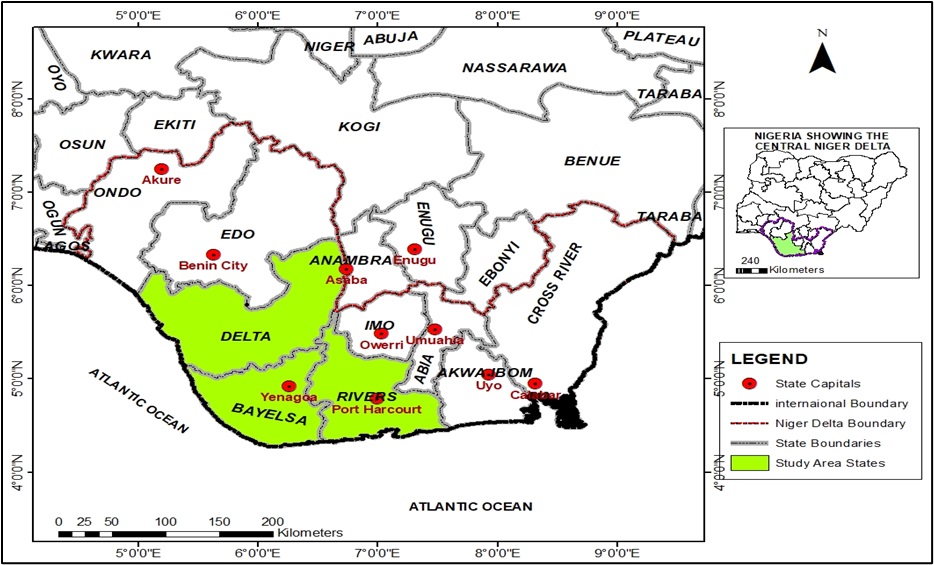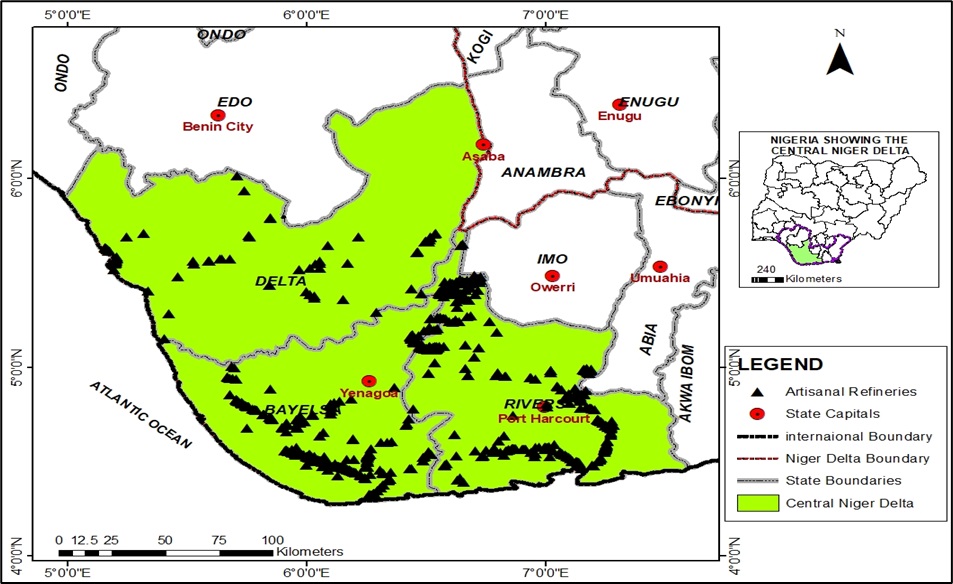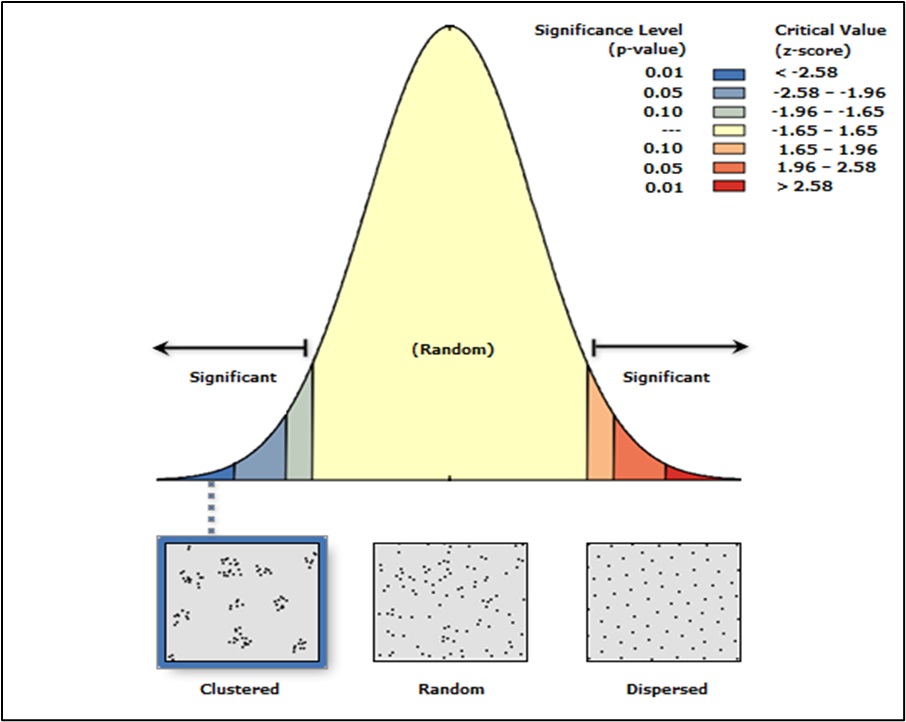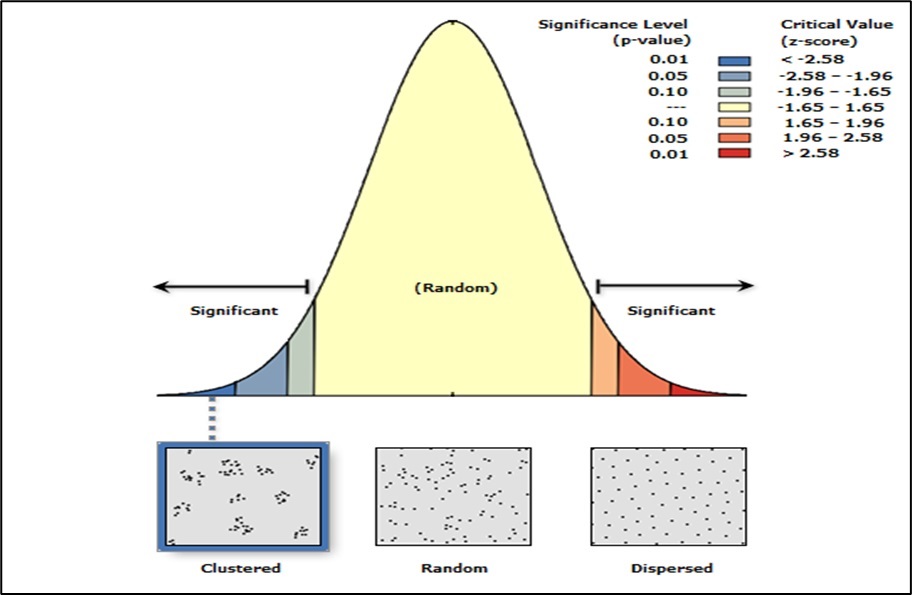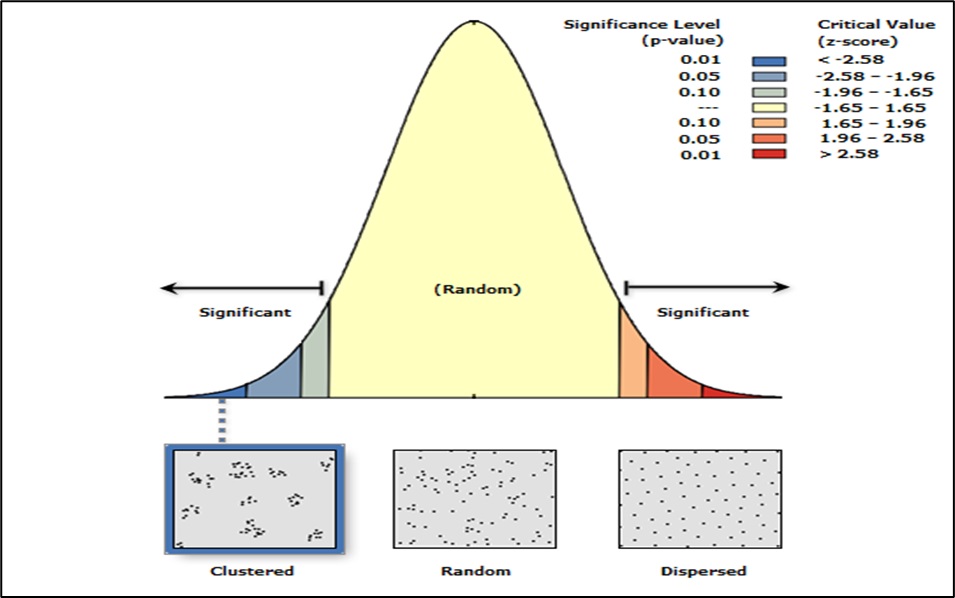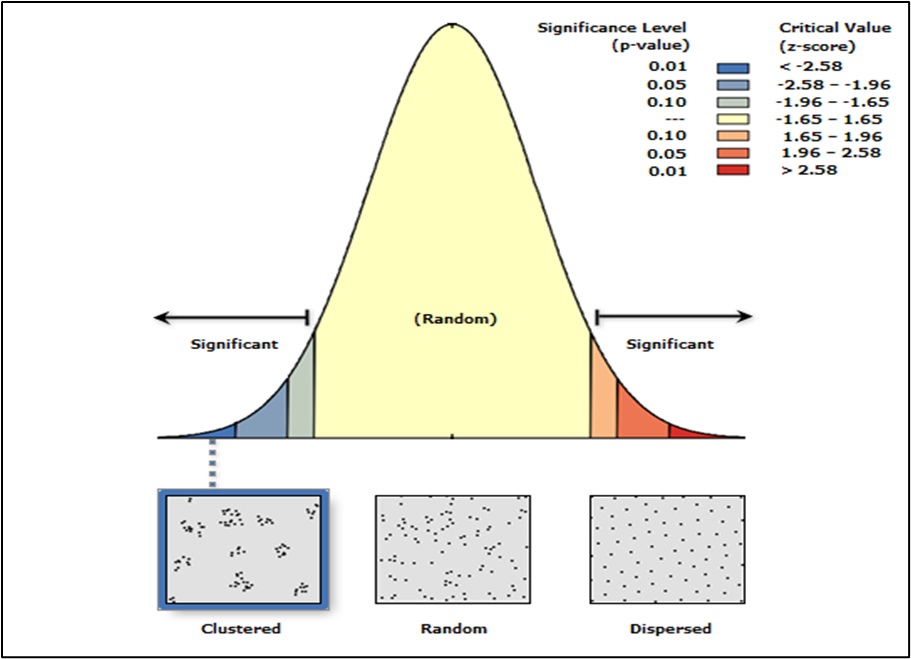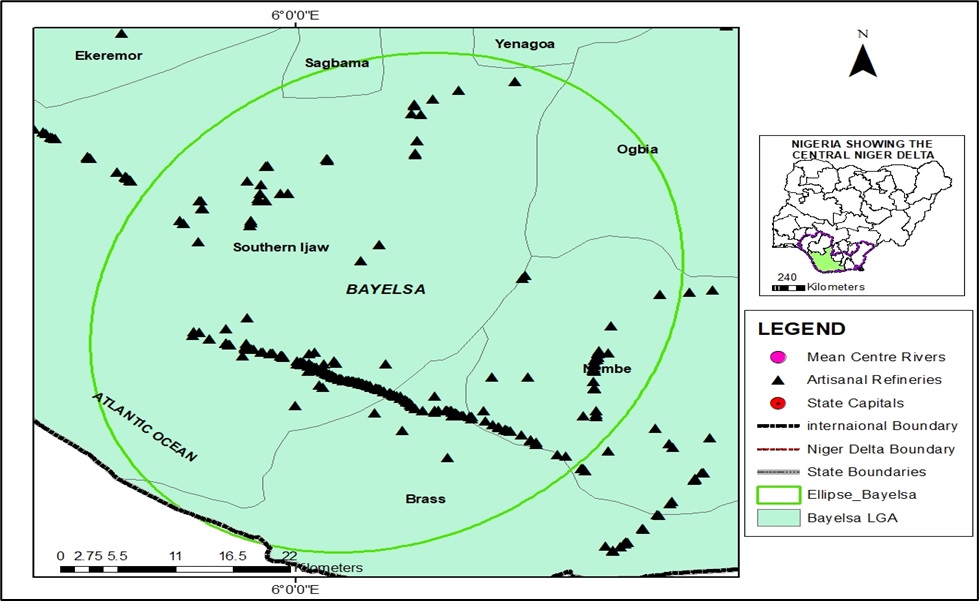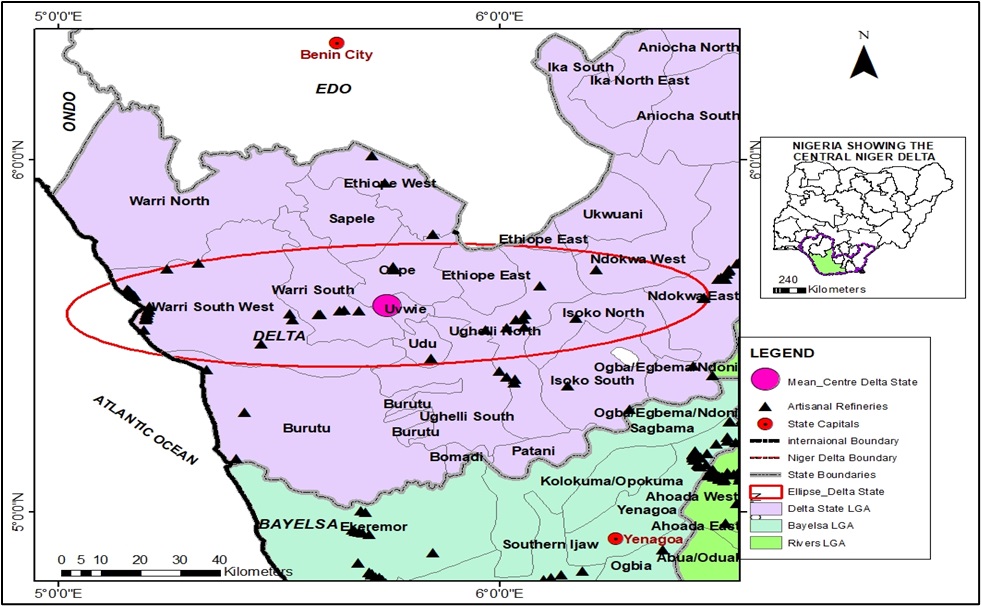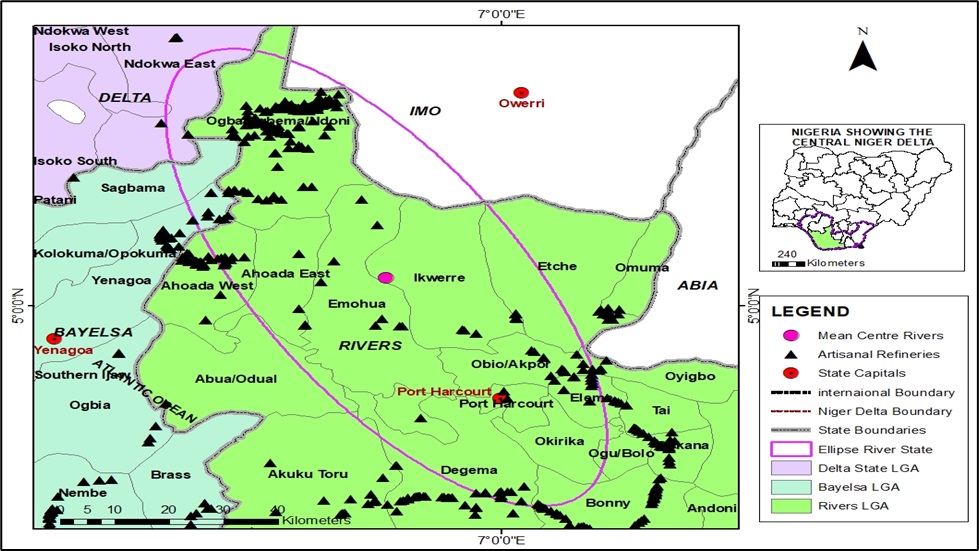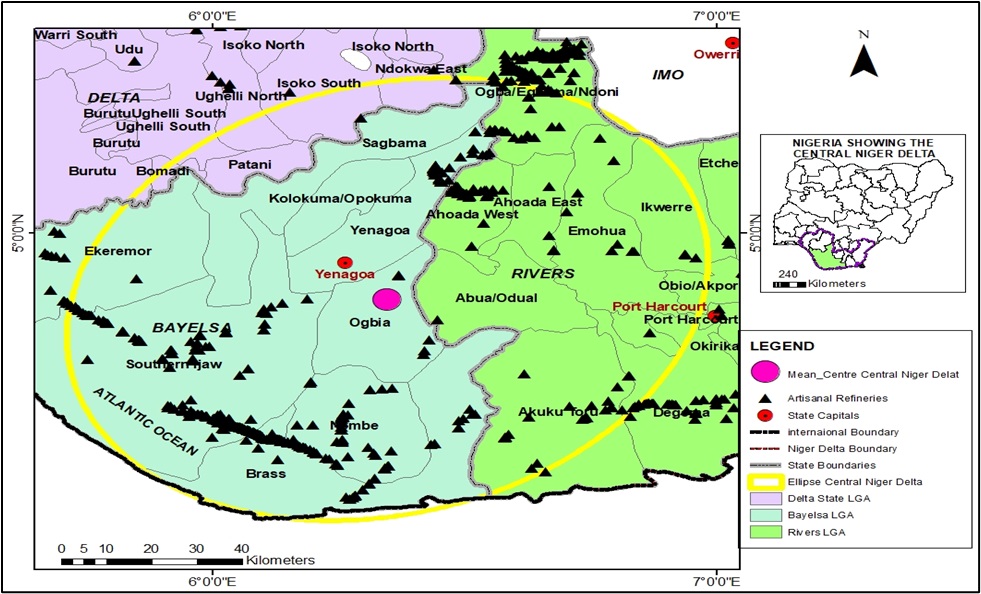Geospatial Analysis of Artisanal Refineries Distribution Pattern in the Central Niger Delta, Nigeria
- Ikezam P.
- Kika H.A.
- 548-558
- Apr 25, 2024
- Sociology
Geospatial Analysis of Artisanal Refineries Distribution Pattern in the Central Niger Delta, Nigeria
Ikezam P. 1 & Kika H.A. 2*
1Department of Geography and Environmental Management, University of Port Harcourt, Port Harcourt, Nigeria
2Department of Geography and Environmental Studies, Ignatius Ajuru University of Education, Rumuolumeni, Port Harcourt, Rivers State, Nigeria
*Corresponding Author
DOI: https://doi.org/10.51584/IJRIAS.2024.90349
Received: 05 March 2024; Accepted: 19 March 2024; Published: 25 April 2024
ABSTRACT
The study examined the geospatial analysis of geospatial analysis of artisanal refineries distribution pattern in the Central Niger Delta, Nigeria. The study made use of locational data obtained as secondary data from National Oil Spill Monitor and National Oil Spill Detection and Response Agency. Geographic analyses such as nearest neighbour analysis, directional distribution (Standard deviation ellipse), and Mean Center were carried out. Descriptive statistics involving spatial extent, frequency and percentage were employed for the data analysis. The results showed that that a total of 1476 artisanal sites were discovered in the Central Niger Delta. Of this total 55.35% (817) were found in Bayelsa State, 5.49% (81) were found in Delta State and 39.16% (578) were found in Rivers State. The nearest neighbour analysis showed that the distribution pattern of artisanal refineries was significantly clustered in Bayelsa State (Z= 47.5252, p=0.000); Delta State (Z= -10.129, p=0.0000); Rivers State (Z= -35.13333, p=0.0000) and the entire Central Niger Delta (Z= -59.8222, p=0.0000). The mean center of the distribution of artisanal refineries in Bayelsa State was found in Southern Ijaw LGA, Delta State in Uvwie LGA, Rivers State is found in Ikwerre LGA, and the entire Central Niger Delta was found in Ogbia LGA. The directional distribution standard deviation ellipse covered 58.49% in Bayelsa State, 35.06% in Rivers State and 6.35% of dispersion in Delta State. The study can be concluded that the spatial distribution pattern of artisanal refineries in the entire Central Niger Delta was clustered in nature and Bayelsa and Rivers States were more affected. It is recommended to among others that more studies should be done on the proliferation of artisanal refineries in the study area and entire Niger Delta so that the environmental effects resulting from artisanal refinery activities are reduced to the barest minimum.
Keywords: Spatial, Artisanal, Refinery, Distribution pattern, Central Niger Delta
INTRODUCTION
Artisanal refining is the refining of crude oil with the use of indigenous resources and skills by collecting the crude oil into drums and heating them to boiling afterwards allowing them to cool and condense. Artisanal refineries apply the same principle of distillation used by conventional refineries. It involves the buying of stolen crude oil and refining those using local resources and skills. In other words, legal artisanal refineries can be regarded as modular refinery which is regarded as a miniature form of conventional refinery constructed in a fragmented way (Brown et al, 2003; Igwe, 2015; Mamudu et al., 2016). The idea of modular refineries which was first mooted in the early 1940’s was revamped in the 1970’s as solutions to the problems linked to conventional refineries (Hogan 2013). Globally the idea of modular refineries is applied when the refined product falls short of demand. Its idea was that of a temporary refinery which can easily be hidden or dismantled as need arises (Duncan & Knox, 1991). The setup of a modular refinery allows for refinery three major functions such as crude oil separation, conversion and treatment (Mamudu et al., 2019). This includes separation of crude oil into different fractions such as diesel, kerosene, naphtha, petroleum gas and other bye products by the distillation unit in a relatively cheap process compared to the conventional refineries. Hydro skimming unit to ensure high octane unleaded gasoline and LPG which may include the addition of isomerization unit to boost the total octane rating and produce premium unleaded gasoline.
As noted in Onuh et al (2021), it is reported that while the activities of multinational oil corporations contribute significantly to oil pollution and environmental degradation in most oil-producing countries, the extent to which illegal artisanal refineries contribute to the environmental problems in Niger Delta remains unclear. Extant literature attributes this to the expanding activities of the artisans as well as the use of crude technology in illegal oil refining. Given the widespread nature of the artisanal oil-refining economy in the Niger Delta region, we assess its contribution to the growing environmental pollution in the region. By artisanal oil refining, it is meant that small-scale crude oil processing or subsistent distillation of petroleum that is often outside the boundaries of the state law. In the Niger Delta creeks, artisanal oil refining constitutes part of the economic activities and revenue source for many young persons. This has led to the environmental pollution of the area due to artisanal oil refining. Most Niger Delta indigenes regard the act of illegal refining as reaping from their natural resource. Crude methods are employed in the refining process with thermal cracking used in breaking down the petroleum into its useful components at different temperatures (Akanimo, 2013). This gives rise to what is commonly called adulterated product and the entire activity termed illegal.
Presently, Nigeria invests heavily on imported refined petroleum products as a result of the inability of our local refineries to cope with the increasing demands. This has led to the export of crude oil in meager amounts compared to that expended in the import of refined products. According to the National Bureau of Statistics 2017, Nigeria imported approximately 22.5 billion liters of refined petroleum product in 2017 out of which 17.31 billion liters of petrol, 4.28 billion liters of diesel, 340.33 million liters of household kerosene, 592.73 million litres of aviation turbine kerosene and 15.61 million liters of low pour fuel oil were imported.
In Nigeria, scholars have carried out different studies on spatial analysis of different phenomena to demonstrate the efficiency of geospatial tools in Nigeria. It has equally been applied in educational facilities (Aliyu et al, 2013); health issues (Oviasu et al, 2015); ecotourism (Odum et al., 2018) while Omogunloye and Ayeni (2012) and Kika and Ikezam (2022) analysed the hotels in Lagos State and Port Harcourt respectively. However, very few of the studies considered the use of GIS to assess the spatial distribution pattern of artisanal establishment or location. The present study is focusing at analyzing the spatial distribution patterns of artisanal refineries in the Central Niger Delta with a view to assessing and quantifying their spatial dispersion with distance from the mean center of the distribution.
MATERIALS AND METHODS
The study area was carried out in the Central Niger Delta comprising Bayelsa, Delta and Rivers States. Geographically, the Niger Delta is described as a unique ecological zone by virtue of its size and geophysical configuration (Mmom, 2003). It is one of the world’s largest wetlands covering an area of approximately 70,000 km2, located in the south-south geopolitical region of Nigeria. It lies between latitude 4º and 6º North of the equator and longitude 5º and 7º East of Greenwich. Along the coast, the Niger Delta as shown in Fig. 1, stretches from the Benin River in the West to Bonny River in East, while in land, it begins a few miles below Aboh at a point where river Niger bifurcates into river Nun and Forcados into the Atlantic West at the South, stretching over 160 miles (Iyalla, 2001). The study area has a tropical monsoon climate with mean annual temperature of 28oC and annual rainfall over 2500mm. The relative humidity is very high with an annual mean of 85%. The relief is generally lowland which has an average of elevation between 20m and 30m above sea level and the geology of the area comprises basically of alluvial sedimentary basin and basement complex. The vegetation found in this area includes raffia palms, thick mangrove forest and light rain forest. The soil is usually sandy or sandy loam underlain by a layer of impervious pan and is always leached due to the heavy rainfall. The study area is well drained with both fresh and salt water. The salt water is caused by the intrusion of sea water inland, thereby making the water slightly salty. The area is occupied by rainforest, freshwater swamp and mangrove swamp in some cases, which has been drastically modified by human activities. The vegetation is nourished with high rainfall and high temperature, which provide favourable condition for the growth of a varieties of tall and big trees like mahogany, Obeche, Afara and abundance of oil palm trees and several other species of economically valuable plants such as raffia palms, Abura, ferns and grasses (Eludoyin et al, 2013). The city is a major industrial centre as it has a large number of multinational firms as well as other industrial concerns, particularly business related to the petroleum industry (Austin, 2010).
Figure 1. Central Niger Delta
The study made use of the data of location of bunkering sites across the Niger Delta obtained as secondary data from National Oil Spill Monitor and National Oil Spill Detection and Response Agency (NOSDRA) from where those within the Central Niger Delta were clipped from. The data contained the latitudes and longitudes of the location and the names of the companies owing the facility being bunkered. Descriptive statistics were employed in the data and geographic analyses carried out included the nearest neighbour analysis, dispersion extent using directional ellipse and mean centre of the distribution of artisanal refinery. Results are presented using tables and graphs.
RESULTS AND DISCUSSIONS
Spatial Distribution of Artisanal Refinery
The analysis of the spatial distribution of artisanal refinery in the Central Niger Delta can be foond in Table 1 and Figure 1. The analysis showed that a total of 1476 artisanal sites were discovered in the Central Niger Delta. Of this total 55.35% (817) were found in Bayelsa State, 5.49% (81) were found in Delta State and 39.16% (578) were found in Rivers State.
Table 1. Frequency of Artisanal Refineries in Central Niger Delta
| States | Number | Percentage (%) |
| Bayelsa | 817 | 55.35 |
| Delta | 81 | 5.49 |
| Rivers | 578 | 39.16 |
| Total | 1476 | 100.00 |
Figure 2. Distribution of Artisanal Refineries in Central Niger Delta
Spatial Distribution Pattern of Artisanal Refineries in Central Niger Delta
The results of the analysis shown in Table 2, Figure 3, Figure 4, Figure 5, and Figure 6 explain the spatial distribution pattern of artisanal refineries in the Central Niger Delta. In Bayelsa State, the distribution pattern of artisanal refineries was significantly clustered (Z= 47.5252, p=0.000). Similarly, the distribution pattern of artisanal refineries was significantly clustered in Delta State (Z= -10.129, p=0.0000); Rivers State (Z= -35.13333, p=0.0000) and the entire Central Niger Delta (Z= -59.8222, p=0.0000).
Table 2: Spatial Distribution Pattern of Artisanal Refineries in Central Niger Delta
| Parameters | Bayelsa State | Delta State | Rivers State | Central Niger Delta |
| Observed Mean Distance (m) | 229.3637 | 2573.3986 Meters | 543.0458 | 454.9812 |
| Expected Mean Distance (m) | 1752.5538 | 6250.7918 Meters | 2299.8341 | 2445.2748 |
| Nearest Neighbor Ratio: | 0.130874 | 0.411692 | 0.236124 | 0.186065 |
| z-score: | -47.525276 | -10.129277 | -35.133201 | -59.822361 |
| p-value: | 0.000000 | 0.000000 | 0.000000 | 0.000000 |
Figure 3. Nearest Neighour Analysis for the Spatial Distribution Pattern of Artisanal Refineries in Delta State
Figure 4. Nearest Neighbour Graph for the Spatial Distribution of Artisanal Refineries in Rivers State
Figure 5. Nearest Neighbour Graph for the Spatial Distribution of Artisanal Refineries in Bayelsa State
Figure 6. Nearest Neighbour Graph for the Spatial Distribution of Artisanal Refineries in Central Niger Delta
Ellipse and Mean Centre of Artisanal Refinery Operation in Central Niger Delta
The ellipse mean centre depicting the dispersion of the distribution of artisanal refinery operation in the Central Niger Delta are shown in Table 3, Figure 7, Figure 8, Figure 9 and Figure 10. The analysis reveals that the mean centre of the distribution of artisanal refinery was found in Southern Ijaw LGA and the nearest community to the mean center was Ikorumogbene. Furthermore, it was discovered that the mean centre in Delta State was found in Uvwie LGA, around Tori community. In addition, the mean centre in Rivers State was found in Ikwerre LGA and the nearer communities were Elele and Elele Alimini. Generally, in the Central Niger Delta, the mean centre for the distribution of artisanal refinery was found in Ogbia LGA in Bayelsa State and the close communities were Kala Emeya and Opu Emeya.
Table 3. Ellipse and Mean Centre of the Distribution of Artisanal Refinery Operation
| State | Mean Centre Location by Local Government | Nearer Towns |
| Bayelsa | Southern Ijaw | Ikorumogbene |
| Delta | Uvwie | Tori |
| Rivers | Ikwerre | Elele, Elele Alimini |
| Central Niger Delta | Ogbia | Kala Emeya, Opu Emeya |
Table 4 explains the summary of the extent of dispersion of artisanal refineries by LGAs using ellipse as can be viewed in Figure 6, Figure 7, Figure 8 and Figure 9. Out of the total of 8 LGAs in Bayelsa State, 75% (6) were involved. Similarly, in Delta State, 62.07% (18) were affected out of 29, 95.65% (22) out 23 in Rivers State. Generally, in the central Niger Delta, 45% (27) of the LGAs were affected out of 60 LGAs.
Looking at the directional ellipse from Figure 7, it could be found ellipse of the distribution of artisanal refineries in Bayelsa State ran from Southeast to Northwest with bulged shape covering largely Southern Ijaw, Brass, Nembe and Ogbia LGA. In addition, small part of Yenagoa and Sagbama were captured by the ellipse. It was gathered that only Ekeremor LGA was out of the ellipse. In Figure 8 describing the dispersion of artisanal refineries in Delta State, the ellipse ran perfectly from the East to West in a compressed form. Undoubtedly, the ellipse covered Warri Southwest LGA, Warri South LGA, Udu LGA, Ughelli North LGA, Isoko North LGA, Ndokwa East LGA, Ethiope LGA, Uvwie LGA, small part of Sapele LGA and Ethiope East LGA. In Figure 9, the dispersion of artisanal refinery locations in Rivers State appeared to be running from the Southwest to Northeast largely covering Okirika LGA, Degema LGA, Obio Akpor LGA, Port Harcourt LGA, Emohua LGA, Ikwerre LGA, Ahoada East LGA, Ogba/Egbeme/Ndoni LGA and small part of Etche LGA and Ahoada West LGA. Considering the totality of ellipse dispersion as revealed in Table 5 and Figure 10, it is discovered that 58.49% of the dispersion fell into Bayelsa State which was found to be the highest. Following this is Rivers State which had 35.06% and Delta State had 6.35% of the dispersion. It could be seen that only 0.09% was out the study area.
Table 4. Extent of Dispersion of Artisanal Refinery by LGAs using Ellipse
| State | LGAs Affected by the Dispersion | Total Number | Percentage Affected (%) |
| Bayelsa | 6 | 8 | 75.0 |
| Delta | 18 | 29 | 62.07 |
| Rivers | 22 | 23 | 95.65 |
| Central Niger Delta | 27 | 60 | 45% |
Table 5. Ellipse Dispersion based on States
| States | Spatial Coverage (km) | Percentage (%) |
| Bayelsa | 7903.76 | 58.49 |
| Delta | 858.66 | 6.35 |
| Rivers | 4738.06 | 35.06 |
| Out of Study Area | 12.61 | 0.09 |
| Total | 13513.09 | 100.00 |
Figure 7. Ellipse and Mean Centre of Artisanal Refinery in Bayelsa State
Figure 8. Ellipse and Mean Centre of Artisanal Refinery in Delta State
Figure 9. Ellipse and Mean Centre of Artisanal Refinery in Rivers State
Figure 10. Ellipse and Mean Centre of Artisanal Refinery in Central Niger Delta
CONCLUSION AND RECOMMENDATIONS
The study has demonstrated the ability of GIS to handle the spatial distribution pattern of artisanal refineries which was known to be clustered in Bayelsa, Delta and Rivers State and generally in the Central Niger Delta. It is also concluded that the artisanal refineries are more established in Bayelsa and Rivers States than Delta State. The study recommended that a GIS database is required for the monitoring and management of the establishment of artisanal refineries and more studies should be done on the proliferation of artisanal refineries in the study area and in the entire Niger Delta so that the environmental effects resulting from the activities from the artisanal refineries are reduced to the barest minimum.
REFERENCES
- Aliyu A., Shahidah M. A., Aliyu R. M. (2013) Mapping and spatial distribution of post primary schools in Yola North Local Government Area of Adamawa State, Nigeria.
International Journal of Science and Technology. Vol. 2. No. 5. Pp. 405-422. - Aniah, E. J., Okim, D. O., Eja, E. I. and Ushie, M. A. (2010). The spatial distribution, analyses and composition of lakes as ecotourism potentials in Cross River State, Nigeria.
International Journal of Creativity and Technical Development. Vol. 2. Nos. 1-3. Pp. 45-50 - Duncan, JW & Knox, L (1991). Overland Petroleum Processor. US Patent 4983259, EIA. Petroleum supply annual 2004.Available at http://www.eia.doe.gov./kids/index.cfm. Retrieved 29th January, 2019.
- Eludoyin O.S., Oderinde F.A. and Azubuike, O.J. (2013): Heavy metals concentration under rubber plantation (Hevea brasiliensis) in Hydromophic Soil of South-South Region of Nigeria. Ife Research Publications in Geography (IRPG), Obafemi Awolowo University, Ile Ife, Vol. 12 No.1 and 2. Pp 107-119,
- Hogan, M.C. (2013). Niger River. In M. McGinley (ed.), Encyclopedia of Earth, Washington, DC: National Council for Science and Environment.
- Igwe, G.J. (2015). Modular refineries will address perennial shortage of petroleum products. Available at http://businessnews. com.ng/ 2014/09/08/modular-refineries-will-address perennialshortage -petroleum-products-igwe/e.ahe.
- Mamudu A, Okoro E, Igwilo K, Olabode O., Elehinafe F., & Odunlami. O. (2019). Challenges and Prospects of Converting Nigeria Illegal Refineries to Modular Refineries in Nigeria. J afri studies, 13 (4), 29-49. DOI: 2174/1874123101913010001
- Mamudu, O.A., Igwe, GJ and Okonkwo, E (2016). Process Design Evaluation of an Optimum Modular Topping Refinery for Nigeria Crude Oil using HYSYS Software, Society of Petroleum Engineers (SPE) Nigeria Annual International Conference and Exhibition, http://dx.doi.org/10.2118/184342-MS.
- Odum C. J., Akukwe T. I., Andrew-Essien E., Eja I.E. (2018). Spatial Distribution of Ecotourism Resources in Anambra State: A Nearest Neighbour Analysis Approach. American Journal of Social Sciences. Vol. 6, No. 3, pp. 29-38.
- Omogunloye O.G. and Ayeni O. O. (2012). Analysis of Hotels in Lagos State with respect to other Spatial Data. Research Journal in Engineering and Applied Sciences 1(6) 393-403
- Onuh, P. A., Omenma, T. J., Onyishi, C. J., Udeogu, C. U., Nkalu, N. C., & Iwuoha, V. O. (2021). Artisanal refining of crude oil in the Niger Delta: A challenge to clean-up and remediation in Ogoniland. Local Economy, 36(6), 468–486. https://doi.org/10.1177/02690942211071075

